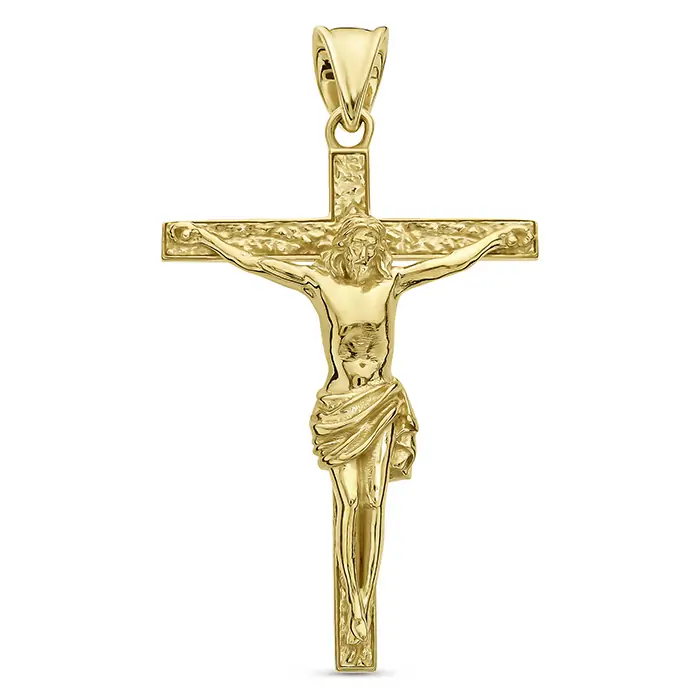The gold crucifix, a symbol steeped in religious history, has transcended its traditional boundaries to become a notable element in modern jewelry design. This article explores how contemporary artists are reimagining this ancient symbol, blending tradition with modern aesthetics.
The Crucifix vs. The Gold Cross
The crucifix, as distinct from a bare cross, features an image of Jesus Christ and is a principal symbol for many Christian groups. It’s particularly important in the Catholic Church, but also used in the Eastern Orthodox Church, most Oriental Orthodox Churches (excluding the Armenian & Syriac Church), Lutheranism, and Anglicanism. The symbol is less common in other Protestant denominations, and in the Assyrian Church of the East and the Armenian Apostolic Church, which prefer to use a cross without the figure of Jesus. The crucifix is a visual emphasis on Jesus’ sacrifice—his death by crucifixion, which is believed to have brought about the redemption of mankind. Most crucifixes portray Jesus on a Latin cross, and Roman Catholics regard the crucifix as the fulfillment of the serpent created by Moses in Numbers 21:8—9, symbolizing healing and salvation.
Contemporary Interpretations
Today’s designers are infusing the gold crucifix with innovative designs. From minimalistic interpretations to ornate, gem-encrusted pieces, these modern crucifixes appeal to a diverse audience, extending beyond the strictly religious to those who appreciate its artistry
The portrayal of the crucifix has evolved over time. Initially, in Christian art, the focus was less on the realistic portrayal of Christ’s suffering and more on the symbol of his victory over evil and death. The earliest known crucifixion scenes depict Christ alive, eyes open, with his Godhead manifest. There are two main types: an “Eastern” style, where Christ wears a long sleeveless tunic, and a “Western” style, where he is nude except for a loin girdle. The Eastern type, originating in Palestine, is exemplified in the 6th-century Rabula Codex and other early Christian art. By contrast, the Western type became prevalent from the Carolingian period.
This evolution in the depiction of the crucifix reflects a broader narrative in Christian art and theology, balancing between the divine and human aspects of Jesus Christ. It also signifies the varied interpretations and theological emphases within different Christian traditions. The gold crucifix, therefore, is not just a religious symbol but also a representation of the rich and diverse history of Christian art and belief.
By the 9th century, there was a shift towards more realistic depictions of Christ’s suffering and death, particularly in Western art. The Eastern Church, following the Iconoclastic Controversy, leaned towards an iconographic portrayal of a nude, dead Christ, emphasizing his humanity while maintaining a strong aversion to sculptured portrayals in the round. Western churches, conversely, have adopted more sculptural and often more graphically realistic representations of the crucifix.
The Traditional Symbolism
Historically, the crucifix represents the crucifixion of Jesus Christ, a central motif in Christian iconography. Its gold representation combines spiritual significance with the allure of precious metal, creating a piece that is both meaningful and beautiful.
Designer Spotlights
We highlight several pioneering designers who are at the forefront of this trend. Each brings a unique perspective, whether it’s through eco-friendly materials, avant-garde designs, or culturally inspired motifs.
Cultural Fusion
The modern gold crucifix often reflects a fusion of cultures, illustrating how this symbol transcends geographical boundaries. Some designs incorporate elements from different artistic traditions, creating pieces that are both universal and deeply personal.
The Role of Technology
Advancements in technology have played a crucial role in these innovative designs. Techniques like 3D printing and laser cutting allow for precision and complexity that were previously impossible, opening up new avenues for creative expression.
The gold crucifix continues to be a versatile and powerful symbol in the world of jewelry. Through the imaginative visions of modern designers, it remains a relevant and cherished emblem, bridging the gap between ancient tradition and contemporary style.







